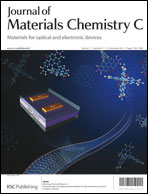Strong negative thermal expansion and relaxor ferroelectricity driven by supramolecular patterns†
Abstract
A supramolecular crystal of 1,4-diazabicyclo[2.2.2]octane hydrochloride, [C6H13N2]+Cl−·3H2O, exhibits extremely strong negative thermal expansion (NTE) and one-dimensional relaxor ferroelectricity, as evidenced by single-crystal X-ray and neutron diffraction, and by dielectric spectroscopy measurements. The highest ever NTE observed in solids, reflected in a volume thermal expansion coefficient of −3.86 × 10−4 K−1, originates from the specific features of the honeycomb sheets formed from hydrogen bonded H2O molecules and Cl− anions. The NTE occurs as a result of H2O molecule rotations, which lead to the proton disorder and to the shortening of hydrogen bonds. The phenomenon is analogous to that in H2O ice, but it is distinguished by the 2D character, a much stronger magnitude, and higher temperature region. The second supramolecular pattern of the crystal, composed of the cations assembled into the strictly linear NH+⋯N bonded aggregates, is responsible for the relaxor-like dielectric response. The frequency-dependent and very high electric permittivity in the order of 1000, observed exclusively along the polycationic chains, results from dipolar fluctuations in the short-range polar regions, generated due to the proton transfers in the NH+⋯N hydrogen bonds. It has been also shown that 1,4-diazabicyclo[2.2.2]octane hydrochloride can be obtained in an anhydrous form, which is built of H-bonded ionic pairs. The loss of water changes the topology of the structure and divests the material’s unprecedented properties.


 Please wait while we load your content...
Please wait while we load your content...